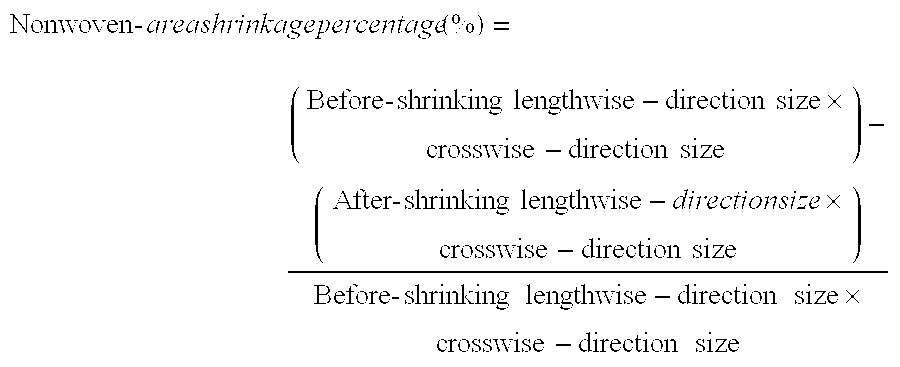Heat-bondable composite fiber, process for producing the same, and fibrous mass
- Summary
- Abstract
- Description
- Claims
- Application Information
AI Technical Summary
Benefits of technology
Problems solved by technology
Method used
Image
Examples
experimental example 1
Evaluation of Fiber Properties and the Nonwoven-Processability
(Sample 1)
[0163]A polyoxymethylene-based polymer was prepared as the first component (the sheath component), of which TA was 156.0° C., MIA was 51, and content of CH2CH2O as the comonomer was 7.1 mass % as the ethylene oxide equivalent (trade name: V40EX-1 produced by Mitsubishi Engineering-Plastics Corporation). A polyoxymethylene-based polymer was prepared as the second component (the core component), of which TB was 169.0° C., MIB was 28, and content of CH2CH2O as the comonomer was 0.9 mass % as the ethylene oxide equivalent (trade name: A30EX-1 produced by Mitsubishi Engineering-Plastics Corporation). These two components were melted and extruded using a sheath-core composite nozzle (an office diameter 0.6 mm: this was the same in the production of the following samples) at a sheath-component spinning temperature of 190° C. and a core-component spinning temperature of 200° C. The composite ratio (volume ratio) of firs...
experimental example 2
Evaluation of Water Retentivity of Nonwoven
[0218](Sample NW-1)
[0219]The water retentivity of a nonwoven of the fibers of the present invention was evaluated. Sample 12 produced in Experimental Example 1 was used to make a parallel web having a mass per unit area of about 70 g / m2 and then the web was subjected to a hydroentangling treatment. The hydroentangling treatment was conducted using a nozzle wherein orifices each having a 0.1 mm diameter were provided in a line at intervals of 0.6 mm. Water streams were applied once to one surface of the web at a water pressure of 3 MPa and the water streams were applied once to the other surface of the web at a water pressure of 3.5 MPa. Then, the web after the hydroentangling treatment was dried with a hot air-through thermal treating machine at 160° C. to give a thermally bonded nonwoven. The resultant nonwoven was cut into a size of 10 cm×10 cm and put into a water bath. The nonwoven was impregnated with water sufficiently not to float an...
experimental example 3
Evaluation of Slippability of Nonwoven
[0223](Sample NW-3)
[0224]The slippability of the nonwoven formed from the fibers of the present invention was evaluated. Sample 1 produced in Experimental Example 150 mass % and rayon fiber (trade name: Corona produced by DAIWABO RAYON Co., Ltd., fineness 1.7 dtex, fiber length 40 mm) 50 mass % were mixed and a parallel web having about a mass per unit area of about 60 g / m2 was made using the mixed fibers. The web was subjected to the hydroentangling treatment. The hydroentangling treatment was conducted using a nozzle wherein orifices each having a 0.1 mm diameter were provided in a line at intervals of 0.6 mm. Water streams were applied to one surface of the web once at a water pressure of 3 MPa and the water streams were applied to the other surface of the web once at a water pressure of 3.5 MPa. Then, the web after the hydroentangling treatment was dried with a hot air-through thermal treating machine at 160° C. to give a thermally bonded no...
PUM
| Property | Measurement | Unit |
|---|---|---|
| Temperature | aaaaa | aaaaa |
| Temperature | aaaaa | aaaaa |
| Temperature | aaaaa | aaaaa |
Abstract
Description
Claims
Application Information
 Login to view more
Login to view more - R&D Engineer
- R&D Manager
- IP Professional
- Industry Leading Data Capabilities
- Powerful AI technology
- Patent DNA Extraction
Browse by: Latest US Patents, China's latest patents, Technical Efficacy Thesaurus, Application Domain, Technology Topic.
© 2024 PatSnap. All rights reserved.Legal|Privacy policy|Modern Slavery Act Transparency Statement|Sitemap

